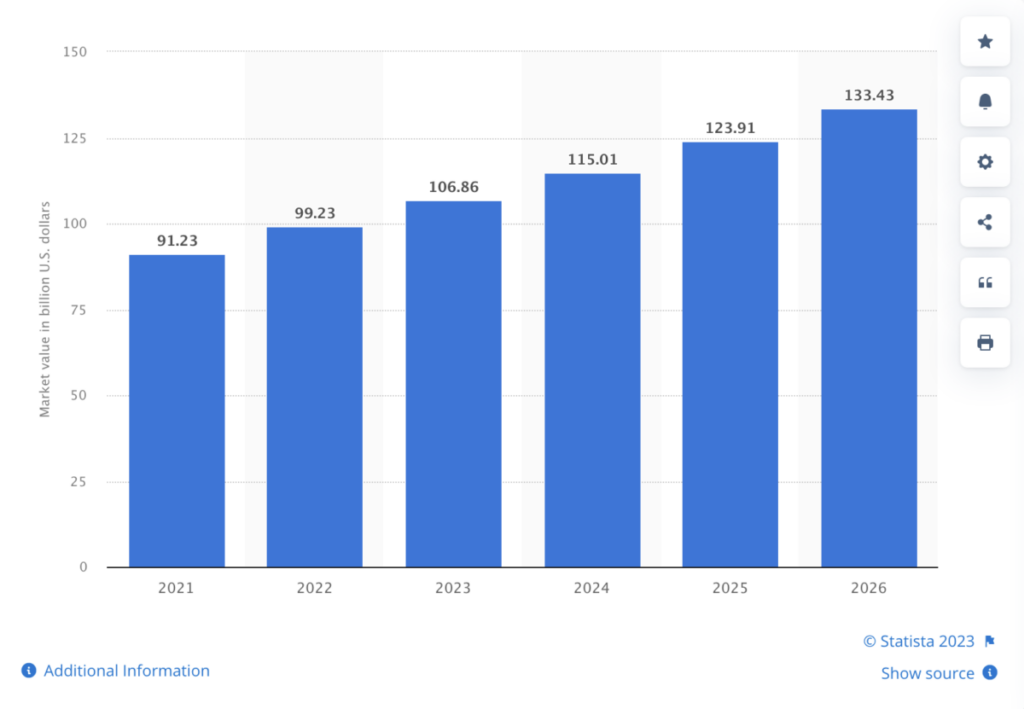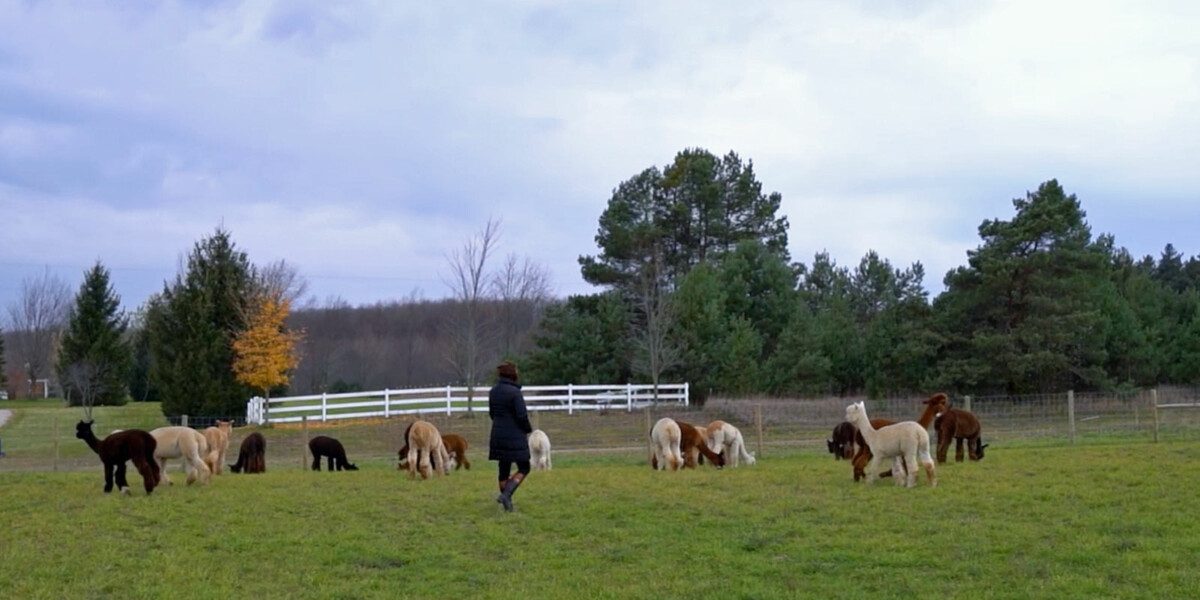This articles was last updated on 01/31/2024.
My twenty-something daughter is a fast fashion fan. Her mother owns an alpaca farm and a flourishing retail business. We are on opposite ends of the sustainability spectrum.
She cares for the environment, and she will go out of her way to recycle and pick up garbage. And yet, fast fashion is part of who she is and the look she craves.
It pains me. The more I know about the sustainability of alpaca clothing, the more I despise the fast fashion industry and all that it represents.
What is Fast Fashion?
Fast fashion is used to describe the fashion industry’s reliance on mass produced, cheap clothing that is sold in large retail chains or online stores. This is done to quickly produce clothing that supports the latest fashion trends shown in fashion shows, Instagram ads, and TikTok videos.
This constant flow of new, cheap clothing is quickly replaced by even newer designs. And to add insult to injury, the clothing is often produced in low wage factories, the material is generally chemical-based, and the environmental repercussions are staggering.
While fast fashion appeals to a wide range of age groups, it is very popular with younger consumers like my daughter. I understand the teens and twentysomething buyers are influenced by social media influencers and ads, but I haven’t figured out why this influence isn’t offset by their love of the environment.

Is Fast Fashion That Bad?
I could probably go on forever about the negative impact fast fashion has on humans and the environment. Its negative environmental impact includes the use of harmful chemicals in production, excessive waste, and poor working conditions. But fast fashion is horrible for even more reasons.
Here is a summary of why fast fashion is so harmful:
- Fast fashion production often involves the use of harmful chemicals and dyes that can pollute water sources and soil.
- The mass production of these trendy clothing items emits huge quantities of greenhouse gases.
- As clothing is washed, plastic debris flows into our water systems.
- The rapid change in clothing styles leads to excessive clothing waste that can be difficult to recycle.
- Fast fashion is often produced in sweatshops and other low-wage labor environments, where workers are subjected to long hours, low pay, and hazardous working conditions.
- Fast fashion workers lack basic employment rights and are paid wages that are insufficient to meet a basic standard of living.
- Fast fashion clothing is often produced from low-quality materials and tends to fall apart after just a few wears.
Now let’s put this into data so it really hits home:
- Since the 2000s, fashion production has doubled, and it will likely triple by 2050.
- The production of polyester has increased nine-fold in the last 50 years.
- It is estimated that 20% of clothing in the US is never worn and in the UK that number jumps to 50%.
- Every year the fashion industry uses 93 billion cubic meters of water, which is enough water to satisfy five million people.
- Around 20% of wastewater worldwide comes from fabric dyeing and treatment.
- Of the total fiber input used for clothing, 87% is incinerated or disposed of in a landfill.
- The fashion industry is responsible for 10% of annual global carbon emissions, more than all international flights and maritime shipping combined. At this pace, the fashion industry’s greenhouse gas emissions will surge by more than 50% by 2030.
What Materials Are Considered Fast Fashion?
To answer this question, The Pretty Planeteer looked at the ten newest items from the top fast fashion brands. When digging into these 390 clothing items, they found the most popular fast fashion materials to be a consistent list of offenders.
Here are the top ten materials used by fast fashion brands:
- Polyester – Polyester is plastic-based (chemical) and not biodegradable.
- Cotton – While cotton is a natural material, it does take a lot of water to produce.
- Elastane, Spandex, or Lycra – This synthetic material requires a lot of toxic chemicals to produce.
- Viscose – Viscose is a plant-based fiber, but it again uses lots of chemicals to process.
- Nylon – This is also plastic and it tends to shed microplastics into the environment.
- Recycled polyester – Another plastic-based material that will shed microplastics into the environment.
- Linen – Linen is the best material on the list because it is made from the inner bark of flax plants.
- Polyurethane – Polyurethane is used as an alternative to real leather. It is a plastic material that sheds microfibers into the environment.
- Rayon – Rayon is made from wood, but it undergoes intense chemical processing.
- Acrylic – Acrylic is a polymer fiber derived from fossil fuels. It requires a lofty chemical process and it breaks down into microplastics.
Which Clothing Brands Are Fast Fashion Offenders?
I am sad to say, I used to be a shopper at some of the largest fast fashion brands on the market. I would zip into H&M for business clothes and hop into Old Navy for casual clothes.
Some of the most well-known fast fashion brands include:
- Adidas
- Ally Fashion
- Abercrombie & Fitch
- Anthropologie
- ASOS
- Autograph
- Bershka
- Boohoo
- Fashion Nova
- Forever 21
- GAP
- Guess
- H&M
- Iniqlo
- Nasty Gal
- New Look
- Old Navy
- Primark
- Primark
- Shein
- Stradivarius
- Topshop
- Uniqlo
- Urban Outfitters
- Victoria’s Secret
- Zara
Thankfully I’m now a lot older and I’m a lot smarter. Owning our alpaca farm and seeing real fiber grow has changed my view of clothing and sustainability.
I now see ads on social media for trendy clothes and it turns my stomach. I don’t want to buy it. Instead, I want to use my farm and influence to educate people on a better way to purchase clothing.
How Can You Avoid Fast Fashion?
To avoid fast fashion is to love the earth. The first step is to learn what fast fashion is and who sells it. The next step is to start using methods to avoid it.
Here are some ways you can step away from the fast fashion lifecycle:
- Buy second-hand or vintage clothing.
- If you have a special occasion and need to wear something only once, rent it.
- Invest in high-quality, timeless pieces. You’ll notice our alpaca store stays clear away from trendy styles and I do this so clothing can serve you for many years to come.
- Shop at sustainable stores that know where clothing comes from, how it is made, and what it is made of.
- Look for clothing that uses natural materials like alpaca fiber, merino wool, cashmere, cotton, hemp, tencel, and bamboo.
- Consider recycled and repurposed clothing. My favorite is older, worn sweaters repurposed into mittens.
- Repair clothing and fight the urge to throw it away.
- Limit how much you wash your clothing. Most garments don’t need to be washed with every wear. Alpaca is perfect for this because it naturally repels odors and stains.
- Buy only what you need.
- Read labels. You’ll see lots of cheap products being pushed as alpaca on social media, but when you reach the website to buy it, you’ll see it contains 5% alpaca and 95% chemicals.
By following these steps, you can reduce your impact on the fast fashion industry and support more sustainable and ethical buying habits.

Why Alpaca is the Exact Opposite of Fast Fashion?
I wouldn’t be writing this article if I didn’t think alpaca was the ultimate answer to fast fashion. I might be biased, but I have done the research and I do know alpaca offers a large amount of goodness that sets it far apart from the synthetic materials listed above.
Here are some of my favorite reasons for considering alpaca as your fast fashion alternative:
- Alpacas are very efficient eaters, so they require low amounts of hay. They tend to consume only 1.8% of their body weight per day in dry matter.
- Alpacas have soft padded feet that are gentle on grass and prevent damage to their environment.
- Alpacas have soft pads for upper teeth which prevent them from ripping grass from the ground while grazing. This allows our pastures to grow back quickly.
- Alpaca poop creates amazing natural fertilizer that is PH balanced and it has very low carbon emissions.
- Because alpacas create communal poop piles, it is easy to collect and compost their poop, so the spread of parasites is controlled.
- Raising alpacas requires no insecticides, herbicides, or fertilizer.
- Alpacas rarely challenge fencing or are destructive to shelters. This means alpaca farmers are not in an endless circle of farm repairs.
- Alpaca fiber is biodegradable.
- Processing alpaca fiber requires no chemicals. This is a huge difference from the materials we looked at above.
- Alpaca comes in 16 different colors naturally. That means you never have to dye alpaca fiber. You can get a beautiful black alpaca hat and no dyes are needed.
- Alpaca fiber is durable. A well-made alpaca sweater can last for many years.
- When we shear, we use virtually every part of the fiber removed from the animal. The prime blanket is used for yarn and clothing items like socks, hats, and gloves. The seconds (lesser fiber) can be used for dryer balls, rugs, and trivets. The thirds (worst fiber) can be used for nesting balls, filler for dog beds, or even insulation for buildings.
If you’ve never experienced wearing alpaca, I encourage you to head on over to our online store and browse through our products. You’ll find a large number of high-quality items, products that are very sustainable, and a wide range of uses.
And if you’re looking for something we don’t offer, just let us know. Our industry is niche and we are close, so I’d be happy to refer you over to another farm or mill if needed.
References
https://www.statista.com/statistics/1008241/fast-fashion-market-value-forecast-worldwide/
https://www.worldbank.org/en/news/feature/2019/09/23/costo-moda-medio-ambiente
https://news.climate.columbia.edu/2021/06/10/why-fashion-needs-to-be-more-sustainable/
https://theprettyplaneteer.com/what-are-fast-fashion-clothes-made-of/
https://www.alpacainfo.com/news/article/5676/celebrate-the-green-alpaca-this-earth-day
https://www.alpacainfo.com/academy/article/3272/environmental-impact-of-camelids


Informative, inspiring and thought-provoking article!
Wow thank you Rebecca. I honestly never thought of fashion in those terms but it all makes sense.
I am a chef and feel very passionate about the slow food manifesto. The fast food culture sickens me for all the reasons you mentioned in the article and so many more.
Fast is just plain not good!!!
Thank you so much for opening eyes a little wider.
I know you just impacted how I look at buying clothes forever ♥️